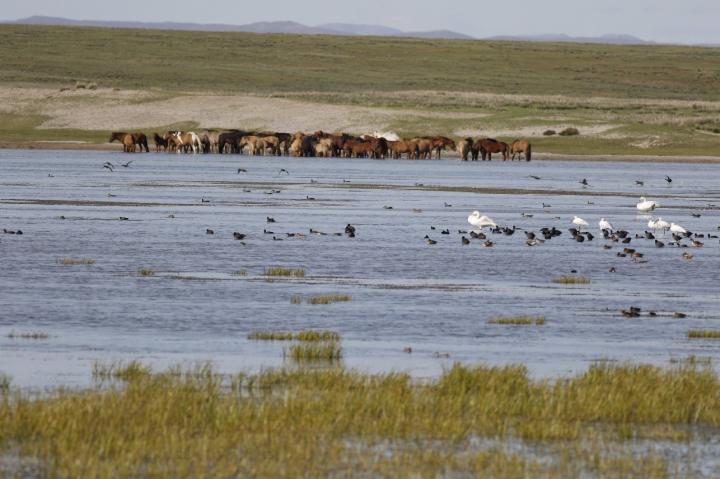
Credit: Ariunbaatar Barkhasbaatar, Wildlife Conservation Society
Avian influenza viruses infect horses in Mongolia but do not cause large outbreaks of disease because they failed to acquire key genetic changes to enable greater cross-species transmissibility, according to a study published February 7 in the open-access journal PLOS Pathogens by Pablo Murcia of the MRC-University of Glasgow Centre for Virus Research, and colleagues. Future studies aiming at understanding those blocks to cross-species transmission using avian and equine influenza viruses will provide insight on the mechanisms and determinants that underpin influenza emergence in mammals.
Viral diseases pose a constant threat to humans and animals. Occasionally, viruses establish in new hosts, sometimes with devastating consequences. It is not clear what allows a virus to infect and become transmissible in a new population, but ecology and evolution play an important part in this process. Influenza A viruses constitute the archetypical example of emerging viruses: their main natural reservoir is in wild birds, but they have also established in humans, pigs and horses. To better understand how influenza A viruses circulate in nature and the ecological and evolutionary factors mediating viral emergence, Murcia and colleagues sequenced more than 20 avian influenza viruses collected from wild birds in Mongolia. By combining field studies, phylogenetics and experimental infections, the authors documented with unprecedented detail the stages that precede initial outbreaks during viral emergence in nature.
The results revealed that the avian influenza viruses are genetically related to a virus that caused an equine influenza outbreak in 1989. Experimental infections showed that most avian influenza viruses replicate in the respiratory tract of the horse without causing any tissue damage. Moreover, horses in Mongolia have been regularly exposed to them over a broad geographical area without causing clinically evident outbreaks. The findings suggest that equine infections by avian viruses able to replicate in horses are more common than originally thought, and that the failure to acquire key genetic changes is the main barrier to disease emergence. According to the authors, surveillance efforts should be directed to monitor for the presence of horse-adaptive mutations in viruses derived from birds.
“New influenza viruses fail to emerge in horses despite abundant ecological opportunities, Murcia adds. “This is likely due to the inability of the viruses to acquire the necessary changes in their genome to adapt to horses.”
###
Research Article
Funding: Support for this project was provided by the National Institute of Allergy and Infectious Disease, National Institutes of Health, Department of Health and Human Services (Contract HHSN266200700007C). PRM was supported by the Medical Research Council of the United Kingdom (Grant MC_UU_12014/9), and the Horserace Betting Levy Board (Grant 779). HR-M was supported by the program PASPA-DGAPA-UNAM. JARA was supported by the University of Glasgow School of Veterinary Medicine VetFund. The funders had no role in study design, data collection and analysis, decision to publish, or preparation of the manuscript.
Competing Interests: The authors have declared that no competing interests exist.
Citation: Zhu H, Damdinjav B, Gonzalez G, Patrono LV, Ramirez-Mendoza H, Amat JAR, et al. (2019) Absence of adaptive evolution is the main barrier against influenza emergence in horses in Asia despite frequent virus interspecies transmission from wild birds. PLoS Pathog 15(2): e1007531. https:/
Author Affiliations:
MRC-University of Glasgow Centre for Virus Research, Glasgow, United Kingdom
State Central Veterinary Laboratory, Transboundary Animal Disease Laboratory, Avian Influenza Section, Ulaanbaatar, Mongolia
Departamento de Microbiología e Inmunología, Facultad de Medicina Veterinaria y Zootecnia, Universidad Nacional Autónoma de México, Ciudad de Mexico, México
Animal Health Trust, Lanwades Park, Kentford, Newmarket, Suffolk, United Kingdom
Wildlife Conservation Society, Bronx, NY, United States of America
School of Public Health, Li Ka Shing Faculty of Medicine, The University of Hong Kong, Hong Kong Special Administrative Region, China
Laboratory Animal Unit, Li Ka Shing Faculty of Medicine, The University of Hong Kong, Hong Kong Special Administrative Region, China
Boyd Orr Centre for Population and Ecosystem Health, Institute of Biodiversity, Animal Health and Comparative Medicine, College of Medical, Veterinary and Life Sciences, University of Glasgow, Glasgow, United Kingdom
Department of Population Medicine and Diagnostic Science, College of Veterinary Medicine, Cornell University, Ithaca, NY, United States of America
In your coverage please use this URL to provide access to the freely available paper: http://journals.
Media Contact
Pablo Murcia
[email protected]
Related Journal Article
http://dx.




